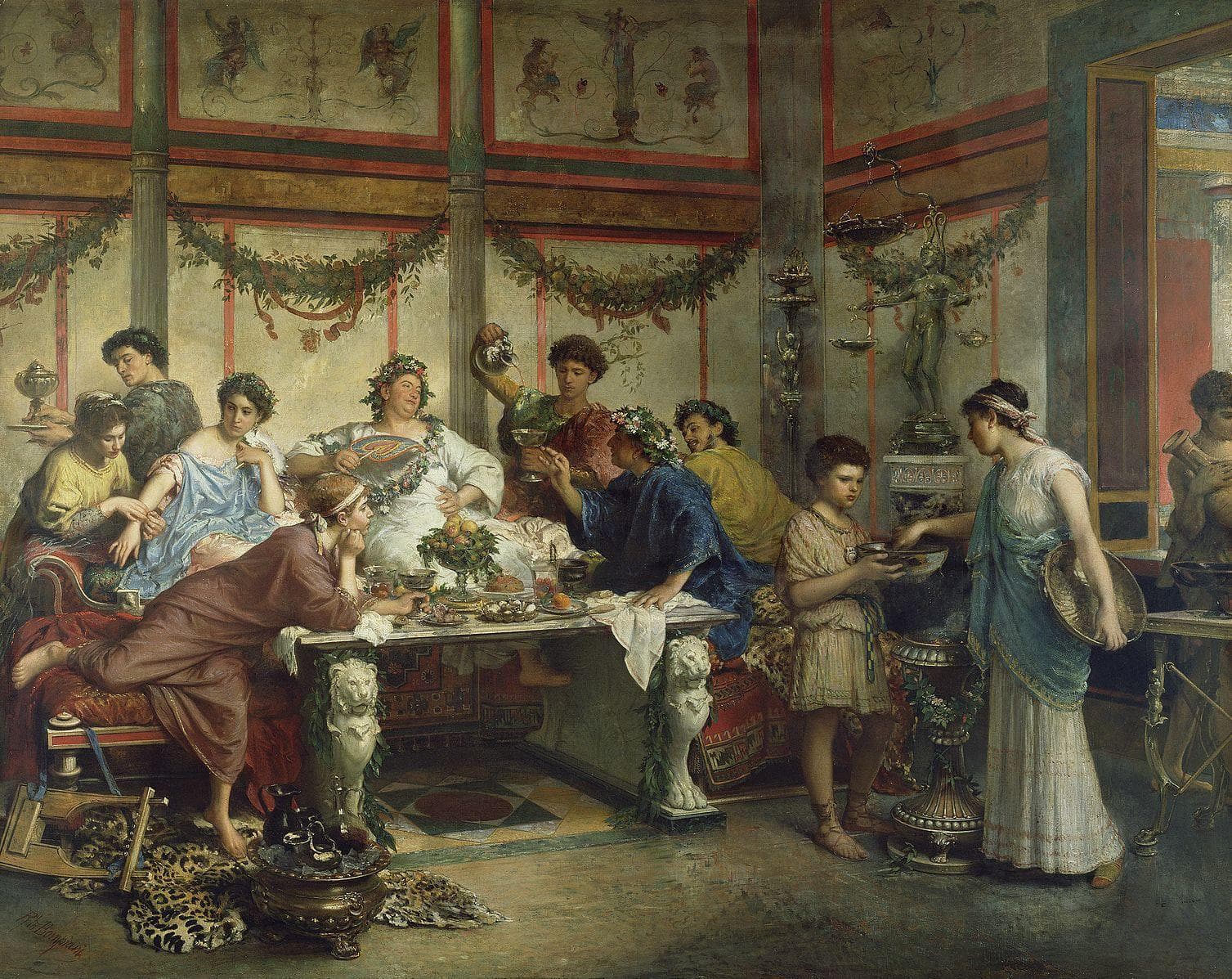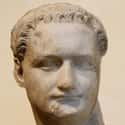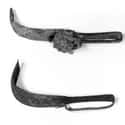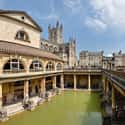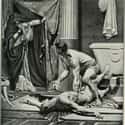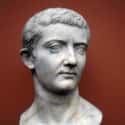-
(#12) Baldness Prompted Emperors To Wear Wigs
Short haircuts were common among emperors, but few relished a thin or fading hairline. According to Suetonius, Emperor Domitian (51-96 AD) wrote a book called On the Care of the Hair, which reads:
Do you not see that I am too tall and comely to look on?
And yet the same fate awaits my hair, and I bear with resignation the aging of my locks in youth. Be assured that nothing is more pleasing than beauty, but nothing shorter-lived.
Displeased with his own hair loss, Domitian had himself depicted in coins and statuary with a full head of hair, and wore a wig later in life.
One of his predecessors, Otho, also wore a hairpiece to hide "the thinness of his locks." Suetonius claimed the wig was "so carefully fashioned and fitted to his head, that no one suspected it."
Emperor Caracalla (188-217 AD) wore a wig as well, but not to hide a balding head. During a tour of the empire, he became "especially fond of the Germans," to the point that he preferred German clothes to his Roman cloak and donned "a yellow wig with the locks arranged in German style."
The Germans were "delighted with the emperor's antics," Suetonius wrote, and "became very fond of him" in turn - though this may have had more to do with his "lavish gifts of money" than his fashion sense.
-
(#3) Emperors, Like All Romans, Would Use A Sickle To Remove Sweat
In many ways, Roman bathing practices were consistent regardless of class. Emperors and common folk alike used a strigil - essentially a small sickle - to wipe away sweat and oil.
After exercising or bathing, Romans covered themselves in oil. They then used a strigil to scrape it off into a guttus, or small pitcher. The process was devoid of soap and was followed by a cold water rinse. Wealthy individuals had slaves scrape them, while poor bathers had to do it themselves.
Excess use of the strigil could have negative consequences. While the rinse after a good strigil scrape was meant to restore moisture, the process was irritating to the skin. Strigils were also quite sharp. Suetonius speculated that Emperor Augustus's "numerous callous places resembling ringworm" were "caused by a constant itching of his body and a vigorous use of the strigil."
-
(#7) Emperors Valued Urine Because Romans Used It To Clean Clothes
Romans didn't have soap in the modern sense, but they did find other ways to clean clothes. One of the most valuable resources for laundry service was urine. Romans used human and animal urine, which were both high in ammonia, to strip clothes of dirt and oil. Traders would gather this commodity from public toilets.
Taxes levied on urine generated revenue to pay Roman troops, a plan first instituted by Emperor Vespasian (9-79 AD). Vespasian's son, Titus, was repelled by the tax, which, according to Suetonius, led to the following exchange:
When Titus found fault with [Vespasian] for contriving a tax upon public conveniences, he held a piece of money from the first payment to his son's nose, asking whether its odor was offensive to him. When Titus said "No," he replied, "Yet it comes from urine."
-
(#13) Augustus's Chief Deputy Designed The First Thermae
Larger public bathing facilities in Rome were known as "thermae." These were often commissioned by emperors and served as a location for socialization.
Thermae featured dressing rooms with holes in the walls for patrons to store their belongings, a tepidarium which contained a pool of warm water, a caldarium which contained a pool of hot water, and a frigidarium which contained a pool of cold water. Some thermaes even had outdoor swimming pools, dry saunas, and a gymnasium.
The very first thermae, which succeeded the smaller bath houses that came before it, was commissioned by Augustus and designed by his chief deputy, Agrippa, in 25 BC. After that, Roman emperors began commissioning larger and more elaborate thermae for public bathing purposes.
-
(#8) Emperors Turned Bathing Into The Ultimate Luxury
Hadrian was a regular visitor at public baths, but Emperor Gallienus (218-268 AD) indulged in as many as six or seven baths daily during the summer months (he only bathed two or three times a day in the winter).
Emperors Gordian and Commodus were said to have bathed often. The latter often took his meals in the bath, and would eventually be slain in the bathroom after being given a glass of wine (or a piece of meat, depending on the source) laced with poison.
The toxic substance didn't end Commodus's life. It was Narcissus, a wrestler and Commodus's fitness coach, who asphyxiated the emperor in his bath. Cassius Dio described the scene:
They [Commodus's enemies] caused Marcia [Commodus's mistress] to administer poison to him in some beef. But the immoderate use of wine and baths, which was habitual with him, kept him from succumbing at once, and instead he vomited up some of it; and thus suspecting the truth, he indulged in some threats. Then they sent Narcissus, an athlete, against him, and caused this man to strangle him while he was taking a bath.
-
(#2) Contemporary Medicine Encouraged Emperors To Leave Their Acne Alone
Emperor Tiberius (42 BC-37 AD) was called "handsome" by Suetonius, though the author noted that he "would break out on a sudden with many pimples."
Acne wasn't without remedy during the 1st century. Medical writer Aulus Cornelius Celsus produced an entire treatise on health, cleanliness, and the treatment of various diseases and afflictions, including skin problems.
In his De Medicina, Celsus wrote, "To treat pimples and spots and freckles is almost a waste of time." However, in the event that one did attempt to remove them, Celsus prescribed the following treatment:
[Pimples are] best removed by the application of resin to which not less than the same amount of split alum and a little honey has been added. A spot is removed by equal quantities of galbanum and soda pounded in vinegar to the consistency of honey. With this the part is to be smeared, and after the lapse of several hours... it is washed off, and the place anointed lightly with oil.
New Random Displays Display All By Ranking
About This Tool
Hygiene in ancient Rome includes the famous public Roman baths, toilets, exfoliating cleaners, public facilities, and usually with high standards of cleanliness. The ancient Romans paid special attention to the cleaning of daily life, and the ancient Roman emperors had perfect cleaning procedures and luxurious bathroom accessories. The Romans, including women and slaves, would wash every day, if not more frequently, there would be a thorough bath at every festival.
Most ancient Roman emperors cared about beauty and cleanness includes hair removal, not just men’s beards, such as Julius Caesar. The random tool described 14 details about what hygiene was like for an ancient Roman emperor.
Our data comes from Ranker, If you want to participate in the ranking of items displayed on this page, please click here.






